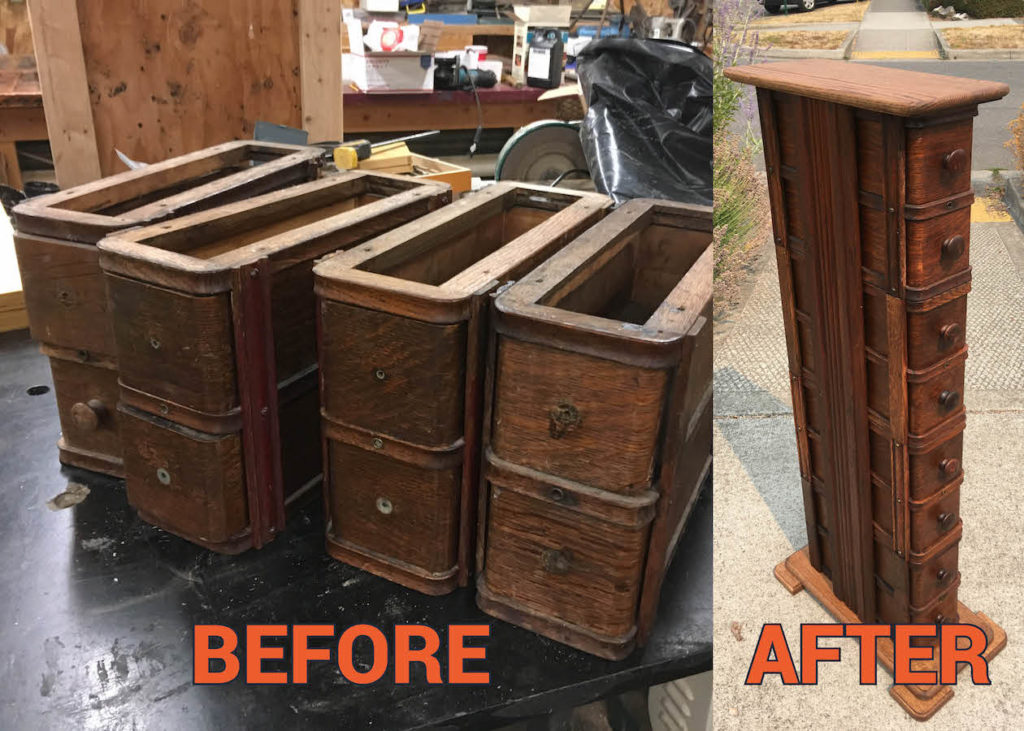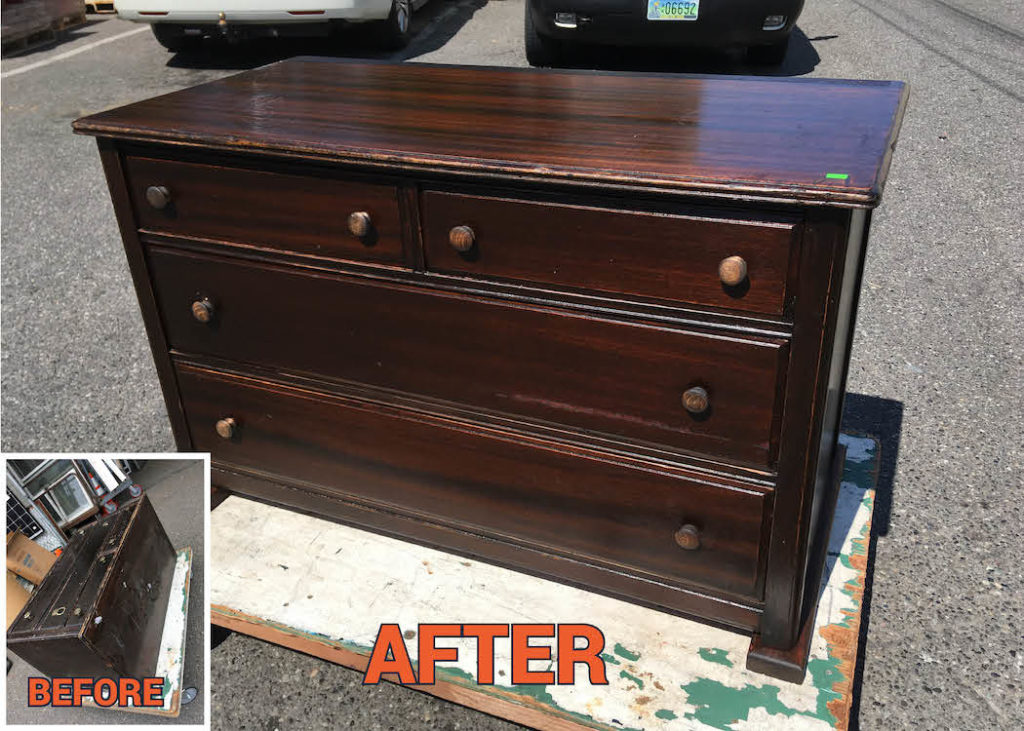
My name is David Spangler and I work in our Revision Division workshop at The RE Store, where my co-worker Matt Vaughn and I build furniture and home accessories from salvaged materials that arrive at our store. I design and build items from scratch, repair broken furniture, and upcycle other items to sell on our sales floor. This year, I started doing something new: refurbish furniture.
So, what does it mean to refurbish furniture?
To me, refurbishing is more than repair and different than a true restoration. It can mean reupholstering, refinishing, adding a different top or seat, repainting or staining, or a complete overhaul. Sometimes, details deemed excessive or outdated are removed or altered and new features are added. Refurbishing takes time and effort, so why do I do it? In our throwaway society, refurbishing furniture is how I honor the forests and raw materials, the original builders, and the many people who have had a hand in making this piece what it is today.
Here’s what motivates me:
It keeps an item relevant and useful – By repairing, cleaning, or changing the color of a piece of furniture, it stays relevant – proving that there is inherent value in the original piece. Cultural trends and needs change, but that doesn’t mean outdated furniture should be thrown away.
It tells a story – In all old pieces there are origins and histories; stories waiting to be uncovered. With each piece, I envision the builders producing similar products on assembly lines in an older time. I picture the machines involved in the sculpting and bending of wood and the knives used to shape the lumber; I hear the noise and smell the sawdust. I imagine the creators perfecting the art of gluing veneers, and the many other manufacturing steps involved to take the piece from raw material to work of art. I don’t try and make the pieces look brand new, I keep the dings and dents. Each blemish hints at the families who used it during its life, sometimes over the course of generations.
 It retains the energy and materials used to build it – While working, I imagine the raw materials utilized to get it to my shop. The hardwoods harvested long ago, the fuel burned by ship, railroad, plane, and truck – each used to haul the raw materials and pieces to and from mills, factories, stores, and homes. I imagine the hundreds of little moments for factory and retail workers of an older America. They followed in their parents footsteps. Many did this for their entire lives. All of this embodied energy is saved when one chooses to refurbish furniture.
It retains the energy and materials used to build it – While working, I imagine the raw materials utilized to get it to my shop. The hardwoods harvested long ago, the fuel burned by ship, railroad, plane, and truck – each used to haul the raw materials and pieces to and from mills, factories, stores, and homes. I imagine the hundreds of little moments for factory and retail workers of an older America. They followed in their parents footsteps. Many did this for their entire lives. All of this embodied energy is saved when one chooses to refurbish furniture.
It adds beauty – Time is beauty and old wood shows it. “Vintage” is hard to replicate when creating a new piece of furniture. With refurbished furniture, cracked and dry finishes easily forgive and gloriously come back to life with a little love and patience. The old world craftsmanship often seen in these pieces, whether by hand or machine, graces our lives with beauty that demonstrates skill and care – the same skill and care that is being lost to pressed-wood construction.
It’s unique – Many people don’t have the skills, time, or space to build their own unique home furnishings. And often, shoppers seek one-of-a-kind items instead of mass-produced pieces that can be found at any store. Refurbishing is an opportunity to celebrate the uniqueness of a piece; something that may be the last of its kind.
 It’s relevant – People want a connection to the past, they want what is real, they want something different, and they don’t want to waste something of value. There is a market for refurbished furniture, and by bringing each piece back to life, I help serve that need.
It’s relevant – People want a connection to the past, they want what is real, they want something different, and they don’t want to waste something of value. There is a market for refurbished furniture, and by bringing each piece back to life, I help serve that need.
It creates local jobs – Big box-store furniture is created by forced labor forces of overseas markets. Homeowners that purchase locally built or refurbished furniture support local businesses that employ local workers. This support inspires small businesses to sprout, not just locally, but all over the country.
Durability – Older pieces are often well-built with raw materials that are of a better quality than found today. This allows them to survive the abuse and neglect of daily life, and makes them great candidates for refurbishing.
When I refurbish furniture, I bring it back to life and back into the lives of people that appreciate it. The raw materials are revered, good design is celebrated, our ancestors are remembered, and the story goes on. It is my belief that people who buy refurbished pieces see that story and want to add their own chapter.

